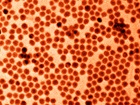|
The hunt is on – for new materials to be used in the next generation of batteries that may one day replace current lithium ion batteries. Today, the latter are commonplace and provide a reliable power source for smartphones, laptops and many other portable electrical devices. On the one hand, however, electric mobility and stationary electricity storage demand a greater number of more powerful batteries; and the high demand for lithium may eventually lead to a shortage of the raw material. This is why conceptually identical technology based on sodium ions will receive increasing attention in coming years. Although researched for 20 years, materials that can store sodium ions remain scarce.
Antimony electrodes?
A team from Empa and ETH Zurich headed by Empa researcher Maksym Kovalenko may have come a step closer to identifying alternative battery materials: they have become the first to synthesize uniform antimony nanocrystals, the special properties of which make them prime candidates for an anode material for both lithium ion and sodium ion batteries. The results of the scientists’ study have just been published in Nano Letters.
For a long time, antimony has been regarded as a promising anode material for high-performance lithium ion batteries as this metalloid exhibits a high charging capacity, by a factor of two higher than that of commonly used graphite. Initial studies revealed that antimony could be suitable for rechargeable lithium and sodium ion batteries because it is able to store both kinds of ions. Sodium is regarded as a possible low-cost alternative to lithium as it is much more naturally abundant and its reserves are more evenly distributed on Earth.
For antimony to achieve its high storage capability, however, it needs to be produced in a special form. The researchers managed to chemically synthesize uniform – so-called “monodisperse” – antimony nanocrystals that were between ten and twenty nanometers in size. Nanocrystals have a decisive advantage over particles of larger sizes: the full lithiation or sodiation of antimony leads to large volumetric changes. Using nanocrystals, these modulations of the volume can be reversible and fast, and do not lead to the immediate fracture of the material. An additional important advantage of nanocrystals (or nanoparticles) is that they can be intermixed with a conductive carbon filler in order to prevent the aggregation of the nanoparticles.
Ideal candidate for anode material
Electrochemical tests showed that electrodes made of antimony nanocrystals perform equally well in sodium and in lithium ion batteries. This makes antimony particularly promising for sodium batteries because the best lithium-storing anode materials (graphite and silicon) do not operate with sodium.
Highly monodisperse nanocrystals, with the size deviation of ten percent or less, allow identifying the optimal size-performance relationship. Nanocrystals of ten nanometers or smaller suffer from oxidation because of the excessive surface area. On the other hand, antimony crystals with a diameter of more than 100 nanometers aren’t sufficiently stable due to aforementioned massive volume expansion and contraction during the operation of a battery. The researchers achieved the best results with 20 nanometer large particles.
Another important outcome of the study, enabled by these ultra-uniform particles, is that the researchers identified a size range of around 20 to 100 nanometers, within which this material shows excellent, size-independent performance, both in terms of energy density and rate-capability. These features even allow using polydisperse antimony particles to obtain the same performance as with very monodisperse particles, as long as their sizes remain within this size-range of 20 to 100 nanometers. Experiments of Kovalenko’s group on monodisperse nanoparticles of other materials show much steeper size-performance relationships such as quick performance decay with increasing the particle size, placing antimony into a unique position among the materials which alloy with lithium and sodium. “This greatly simplifies the task of finding an economically viable synthesis method”, Kovalenko says. “Development of such cost-effective synthesis is the next step for us, together with our industrial partner.”
More expensive alternative
Does this mean that an alternative to today’s lithium ion batteries is within our grasp? Kovalenko shakes his head. Although the method is relatively straightforward, the production of a sufficient number of high-quality uniform antimony nanocrystals is still too expensive. “All in all, batteries with sodium ions and antimony nanocrystals as anodes will only constitute a highly promising alternative to today’s lithium ion batteries if production costs will be comparable,” he says.
It will most likely be another decade or so before a sodium ion battery with antimony electrodes could hit the market. The research on the topic is still only in its infancy. “However, other research groups will soon join the efforts,” the chemist is convinced.
(Author: Peter Rüegg, ETH Zurich)
|


